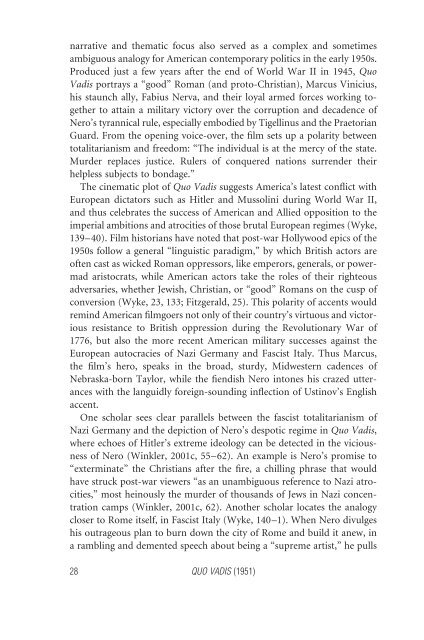Big Screen Rome - Amazon Web Services
Big Screen Rome - Amazon Web Services
Big Screen Rome - Amazon Web Services
Create successful ePaper yourself
Turn your PDF publications into a flip-book with our unique Google optimized e-Paper software.
narrative and thematic focus also served as a complex and sometimes<br />
ambiguous analogy for American contemporary politics in the early 1950s.<br />
Produced just a few years after the end of World War II in 1945, Quo<br />
Vadis portrays a “good” Roman (and proto-Christian), Marcus Vinicius,<br />
his staunch ally, Fabius Nerva, and their loyal armed forces working together<br />
to attain a military victory over the corruption and decadence of<br />
Nero’s tyrannical rule, especially embodied by Tigellinus and the Praetorian<br />
Guard. From the opening voice-over, the film sets up a polarity between<br />
totalitarianism and freedom: “The individual is at the mercy of the state.<br />
Murder replaces justice. Rulers of conquered nations surrender their<br />
helpless subjects to bondage.”<br />
The cinematic plot of Quo Vadis suggests America’s latest conflict with<br />
European dictators such as Hitler and Mussolini during World War II,<br />
and thus celebrates the success of American and Allied opposition to the<br />
imperial ambitions and atrocities of those brutal European regimes (Wyke,<br />
139–40). Film historians have noted that post-war Hollywood epics of the<br />
1950s follow a general “linguistic paradigm,” by which British actors are<br />
often cast as wicked Roman oppressors, like emperors, generals, or powermad<br />
aristocrats, while American actors take the roles of their righteous<br />
adversaries, whether Jewish, Christian, or “good” Romans on the cusp of<br />
conversion (Wyke, 23, 133; Fitzgerald, 25). This polarity of accents would<br />
remind American filmgoers not only of their country’s virtuous and victorious<br />
resistance to British oppression during the Revolutionary War of<br />
1776, but also the more recent American military successes against the<br />
European autocracies of Nazi Germany and Fascist Italy. Thus Marcus,<br />
the film’s hero, speaks in the broad, sturdy, Midwestern cadences of<br />
Nebraska-born Taylor, while the fiendish Nero intones his crazed utterances<br />
with the languidly foreign-sounding inflection of Ustinov’s English<br />
accent.<br />
One scholar sees clear parallels between the fascist totalitarianism of<br />
Nazi Germany and the depiction of Nero’s despotic regime in Quo Vadis,<br />
where echoes of Hitler’s extreme ideology can be detected in the viciousness<br />
of Nero (Winkler, 2001c, 55–62). An example is Nero’s promise to<br />
“exterminate” the Christians after the fire, a chilling phrase that would<br />
have struck post-war viewers “as an unambiguous reference to Nazi atrocities,”<br />
most heinously the murder of thousands of Jews in Nazi concentration<br />
camps (Winkler, 2001c, 62). Another scholar locates the analogy<br />
closer to <strong>Rome</strong> itself, in Fascist Italy (Wyke, 140–1). When Nero divulges<br />
his outrageous plan to burn down the city of <strong>Rome</strong> and build it anew, in<br />
a rambling and demented speech about being a “supreme artist,” he pulls<br />
28 QUO VADIS (1951)



